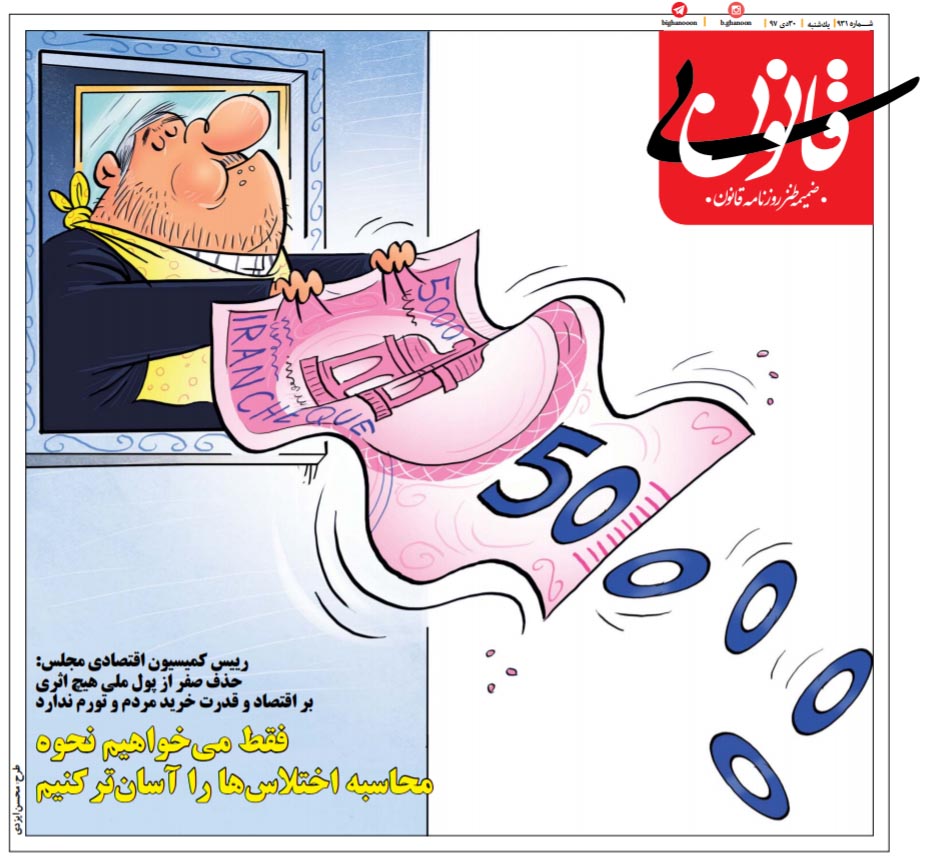August 9, 2019

After decades of discussion and debate, the cabinet has voted to lop four zeroes off the national currency and change the name from the rial to the toman.
The change means that 10,000 rials today will be worth one toman after the shift.
The lopping off of four zeroes was formally proposed in January by Central Bank Governor Abdolnasser Hemmati. The cabinet added the change in name.
The changes must still be voted on by the Majlis and then accepted by the Council of Guardians. There will then be a phase-in period that Hemmati said would take two years.
The rial won’t die as the toman will then be composed of 100 rials. Now the term toman is in informal but widespread use for the sum of 10 rials. But since the change will mean that one rial will be worthy all of 8/100ths of one US cent, it isn’t likely to be heard from much.
Despite worries raised by many, the change by itself won’t have any impact on inflation or the underlying value of the currency. It will simply making the currency easier to handle by getting rid of superfluous zeros.
Government spokesman Ali Rabii said, “It is important to note that the shift has nothing to do with inflation or purchasing power.”
The change, if finally approved, will return the national currency close to the value it held against the US dollar when Reza Shah replaced the qiran with the rial in 1932. At that time, $1 was worth 17 rials. Now one dollar is worth about 110,000 rials. Dropping four zeros would make $1 worth 11 units of currency.
Central Bank officials and Majlis deputies have been talking about dropping some number of zeros for more than a decade, but in the end have done little more than talk. In 2016, the cabinet approved a plan to cut one zero off the currency and change its official name to the toman, making official the term Iranians have long used for 10 rials. But the Majlis never acted on that proposal.
Active opposition to dropping any zeros has come from some hardliners who have argued that dropping zeros would only increase inflation, despite economists telling them repeatedly that there is no relationship between inflation and the number of zeros, and that inflation is the result of mismanagement of the currency.
Hemmati, who became governor of the Central Bank last year, told the state news agency January 6, “A bill to remove four zeros from the national currency was presented to the government by the Central Bank yesterday and I hope this matter can be concluded as soon as possible.” It took eight months, suggesting some haggling inside the cabinet.
The initial reactions in the media last January, both Conservative and Reformist, were generally negative. Many said, correctly, that the change wouldn’t halt inflation—but the Central Bank has never suggested it would.
Deputy Mohammad-Reza Pur-Ebrahimi, chairman of the Majlis Economy Committee, tried to parry the critics by emphasizing that the goal of dropping zeros was not economic, but just to simplify calculations and business transactions.
Opposition surfaced immediately after the cabinet announcement. The state news agency published a report saying it would cost 19.16 trillion rials ($160 million) to change the currency based on the number of banknotes in circulation and the cost to print new ones.
Hemmati said that was nonsense because the government has to print 700 million new banknotes each year anyway because they get old and dirty.
(In the United States, the lifetime of a one-dollar bill is 18 months, and one-dollar bills are 48 percent of all the banknotes in circulation.)
Hemmati said it would take about two years to complete the shift. He did not say how the currency would be dealt with before new notes could be printed. In most countries that drop zeros, the old currency continues to be used for months with everyone just mentally pushing the decimal point to the left.
However, he said the dropping of the four zeros would not be done until after planned banking reforms have been completed. Many remain incomplete.
Hemmati also did not say anything about the name of the currency. Many countries change names when they shift zeroes. But others keep the same name. In 1960, for example, France dropped two zeros and referred to the new currency as the “new franc” and the previous one as the “old franc.”
Dropping zeros has no impact on the value of a currency. Its purpose is simply to make the currency easier for the public to deal with. To halt inflation, new policies must be adopted. In 1923, Germany’s currency went from 2,400 marks per dollar to 4,210,500,000,000 (4.2 trillion) marks. Germany drastically changed its currency policy and at the same time dropped 12 zeros, halting the inflation spree overnight.
More recently, the bottom dropped out of the Zimbabwe dollar in 2008. The country even printed a bill worth 100 trillion Zimbabwean dollars. (See photo above.) In early 2009, the country simply abandoned its own currency and allowed foreign banknotes to be used. It adopted a new currency in February, but that is now collapsing.
The rial was first introduced by the new Qajar Dynasty in 1798. In 1825, the Qajars changed the name to qiran. In 1932, the Pahlavi Dynasty switched from the qiran back to the rial, with the rial worth about six US cents of the day and divided into 100 dinars.
The dinar still legally exists but has been unknown to the public since World War II.
The Pahlavi rial slipped in value from about 6 to the dollar in 1932 to 70 to the dollar by the late 1950s. It remained very stable—one of the world’s most stable currencies for two decades—until the 1979 revolution when it went into a sharp plunge.
